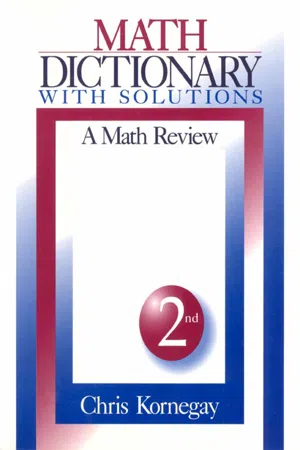Mathematics
Absolute Value Equations and Inequalities
Absolute value equations and inequalities involve expressions within absolute value symbols. When solving absolute value equations, the goal is to find the values of the variable that make the equation true. Absolute value inequalities are solved similarly, but the solution may involve a range of values rather than a single value.
Written by Perlego with AI-assistance
Related key terms
1 of 5
11 Key excerpts on "Absolute Value Equations and Inequalities"
- eBook - PDF
Algebra
A Combined Course 2E
- Charles P. McKeague(Author)
- 2018(Publication Date)
- XYZ Textbooks(Publisher)
A Solving Inequalities with Absolute Values In this section, we will apply the definition of absolute value to solve inequalities involving absolute value. Again, the absolute value of x, which is denoted | x | , represents the distance that x is from 0 on the number line. We will begin by considering three absolute value expressions and their verbal translations: Expression In Words | x | = 7 x is exactly 7 units from 0 on the number line. | a | < 5 a is less than 5 units from 0 on the number line. | y | ≥ 4 y is greater than or equal to 4 units from 0 on the number line. Once we have translated the expression into words, we can use the translation to graph the original equation or inequality. The graph is then used to write a final equation or inequality that does not involve absolute value. 4 5 -7 7 0 -4 -5 0 0 Original Expression Final Expression Graph H20841xH20841 = 7 H20841aH20841 < 5 H20841yH20841 ≥ 4 x = -7 or x = 7 -5 < a < 5 y ≤-4 or y ≥ 4 Image © sxc.hu, emsago, 2003 721 9.4 Absolute Value Inequalities Although we will not always write out the verbal translation of an absolute value inequality, it is important that we understand the translation. Our second expression, | a | < 5, means a is within 5 units of 0 on the number line. The graph of this relationship is which can be written with the following continued inequality: −5 < a < 5 We can follow this same kind of reasoning to solve more complicated absolute value inequalities. EXAMPLE 1 Solve and graph | 2x − 5 | < 3. Solution The absolute value of 2x − 5 is the distance that 2x − 5 is from 0 on the number line. We can translate the inequality as, “2x − 5 is less than 3 units from 0 on the number line.” That is, 2x − 5 must appear between −3 and 3 on the number line. - eBook - PDF
Intermediate Algebra
Connecting Concepts through Applications
- Mark Clark, Cynthia Anfinson(Authors)
- 2018(Publication Date)
- Cengage Learning EMEA(Publisher)
Due to electronic rights, some third party content may be suppressed from the eBook and/or eChapter(s). Editorial review has deemed that any suppressed content does not materially affect the overall learning experience. Cengage Learning reserves the right to remove additional content at any time if subsequent rights restrictions require it. C H A P T E R 2 S y s t e m s o f L i n e a r E q u a t i o n s a n d I n e q u a l i t i e s 206 DEFINITION Absolute Value The absolute value of a real number n, 0 n 0 , is the distance from zero to n on a real number line. Using the distance definition of absolute value guides us when solving equations that contain absolute values. The equation | x | 5 8 is asking what number(s), x, are 8 units from zero on the number line. If we look at the number line, we see that both 8 and 28 are 8 units from zero. ]1 ]2 ]3 ]4 ]5 ]6 ]7 ]8 ]9 ]10 0 1 2 3 4 5 6 7 8 9 10 8 units 8 units The absolute value equation becomes two equations, one for the positive side of zero and the other for the negative side of zero. 0 x 0 5 8 x 5 8 or x 5 28 DEFINITION Absolute Value Equation If n is a positive real number and u is any algebraic expression, then 0 u 0 5 n u 5 n or u 5 2n If n is negative, then the equation 0 u 0 5 n has no real solution. If n is zero, u 5 0. When solving an equation that contains an absolute value, isolate the expression containing the absolute value. Then write two equations, one with a positive value and one with a negative value. Absolute Value Equations Make Two Equations Isolate the absolute value expression. Write as two equations, one equal to the positive constant, one equal to the opposite. 0 2x 2 5 0 5 20 2x 2 5 5 20 or 2x 2 5 5 220 Example 1 Solving absolute value equations Solve the following equations. Check the answer. a. 0 x 1 5 0 5 12 b. 2 0 x 2 4 0 1 3 5 9 c. 0 h 1 3 0 1 10 5 4 SOLUTION a. Step 1 Isolate the absolute value expression. - eBook - PDF
- Mark D. Turner, Charles P. McKeague(Authors)
- 2016(Publication Date)
- XYZ Textbooks(Publisher)
Notice the absolute symbols in the equation. Equations Containing Absolute Value You may recall that the absolute value of x , x , is the distance between x and 0 on the number line. The absolute value of a number measures its distance from 0. Solve for x : x = 5. SOLUTION Using the definition of absolute value, we can read the equation as, “The distance between x and 0 on the number line is 5.” If x is 5 units from 0, then x can be 5 or − 5: If x = 5 then x = 5 or x = − 5 In general, then, we can see that any equation of the form x = b is equivalent to the equations x = b or x = − b , as long as b > 0. We generalize this result with the following property. For any algebraic expression A and positive constant b , If A = b then A = b or A = − b PROPERTY Absolute Value Equations Solve 2 a − 1 = 7. SOLUTION We can read this question as “2 a − 1 is 7 units from 0 on the number line.” The quantity 2 a − 1 must be equal to 7 or − 7: 2 a − 1 = 7 2 a − 1 = 7 or 2 a − 1 = − 7 iStockPhoto.com/©Rob Vomund VIDEO EXAMPLES SECTION 2.6 EXAMPLE 1 EXAMPLE 2 2.6 130 CHAPTER 2 Equations and Inequalities in One Variable We have transformed our absolute value equation into two equations that do not involve absolute value. We can solve each equation using the method in Section 2.1: 2 a − 1 = 7 or 2 a − 1 = − 7 2 a = 8 or 2 a = − 6 Add 1 to both sides a = 4 or a = − 3 Multiply by 1 _ 2 Our solution set is { − 3, 4}. To check our solutions, we put them into the original absolute value equation: When a = 4 When a = − 3 the equation 2 a − 1 ≟ 7 the equation 2 a − 1 ≟ 7 becomes 2(4) − 1 ≟ 7 becomes 2( − 3) − 1 ≟ 7 7 ≟ 7 − 7 ≟ 7 7 = 7 7 = 7 Step 1: Isolate the absolute value on one side of the equation. Step 2: If the constant term on the other side of the equation is positive, proceed to Step 3. If it is zero or negative, treat the problem as a special case. - eBook - PDF
Intermediate Algebra
A Guided Approach
- Rosemary Karr, Marilyn Massey, R. Gustafson, , Rosemary Karr, Marilyn Massey, R. Gustafson(Authors)
- 2014(Publication Date)
- Cengage Learning EMEA(Publisher)
Copyright 2013 Cengage Learning. All Rights Reserved. May not be copied, scanned, or duplicated, in whole or in part. Due to electronic rights, some third party content may be suppressed from the eBook and/or eChapter(s). Editorial review has deemed that any suppressed content does not materially affect the overall learning experience. Cengage Learning reserves the right to remove additional content at any time if subsequent rights restrictions require it. 4.2 Solving Absolute Value Equations and Inequalities in One Variable 243 x f ( x ) = –| x – 1| + 3 y 1 3 Figure 4-10 Graph: f 1 x 2 5 2 0 x 1 2 0 2 3 Solve an equation containing one absolute value term. We discussed that the absolute value of a number is its distance from zero on the number line. The definition of 0 x 0 is as follows: a SELF CHECK 2 2 ABSOLUTE VALUE Assume x is any real number. If x $ 0 , then 0 x 0 5 x . If x , 0 , then 0 x 0 5 2 x . This definition associates a nonnegative real number with any real number. • If x $ 0 , then x (which is positive or 0) is its own absolute value. • If x , 0 , then 2 x (which is positive) is the absolute value. Either way, 0 x 0 is positive or 0: 0 x 0 # 0 for all real numbers x Since 9 $ 0 , 9 is its own absolute value: 0 9 0 5 9 . Since 2 5 , 0 , the opposite of 2 5 is the absolute value: 0 2 5 0 5 2 1 2 5 2 5 5 Since 0 $ 0 , 0 is its own absolute value: 0 0 0 5 0 . Since p < 3.14 , it follows that 2 2 p , 0 . Thus, 0 2 2 p 0 5 2 1 2 2 p 2 5 p 2 2 Comment The placement of a 2 sign in an expression containing an absolute value symbol is important. For example, 0 2 19 0 5 19 , but 2 0 19 0 5 2 19 . In the equation 0 x 0 5 5 , x can be either 5 or 2 5 , because 0 5 0 5 5 and 0 2 5 0 5 5 . In the equation 0 x 0 5 8 , x can be either 8 or 2 8 . In general, the following is true. Unless otherwise noted, all content on this page is © Cengage Learning. Copyright 2013 Cengage Learning. All Rights Reserved. May not be copied, scanned, or duplicated, in whole or in part. - eBook - PDF
The Algebra Teacher's Guide to Reteaching Essential Concepts and Skills
150 Mini-Lessons for Correcting Common Mistakes
- Judith A. Muschla, Gary Robert Muschla, Erin Muschla(Authors)
- 2011(Publication Date)
- Jossey-Bass(Publisher)
Isolate the absolute value expression. 2. If the absolute value equation equals • A positive number, there are two solutions • A negative number, the equation has no solution • Zero, there is one solution EXAMPLES Positive number Negative number Zero | x + 1 | = 10 | 2 x | = − 2 | x − 3 | = 0 Write two equations. No solution. Write one equation. x + 1 = 10 x + 1 = − 10 x − 3 = 0 x = 9 and x = − 11 x = 3 DIRECTIONS: Solve each equation, if possible, or state if the equation has no solution. 1. | x − 3 | = 15 2. | x + 5 | = 0 3. | y − 2 | = − 3 4. | y | − 3 = − 3 5. − 2 | x + 1 | = − 10 6. | 2 y + 3 | = 7 7. − 3 + | x − 5 | = − 1 8. 2 | x + 7 | = − 1 9. 2 | x − 1 | = 4 10. | x − 5 | + 12 = 10 11. − 3 | x + 7 | = 30 12. − 4 | x + 8 | + 13 = − 11 CHALLENGE: Write an absolute value equation that has one solution, x = 2. 105 Copyright © 2011 by Judith A. Muschla, Gary Robert Muschla, and Erin Muschla. All rights reserved. Teaching Notes 3.10: Classifying Inequalities as True or False To determine if an equality is true or false, students must first compare quantities. Combined inequalities and use of the symbols ≤ and ≥ can be particularly confusing. 1. Provide an example of a number line for your students. Review the number line’s properties: • A number is greater than any number to its left. • A number is less than any number to its right. 2. Review the information and examples on the worksheet with your students. Discuss the meaning of the inequality symbols. Particularly emphasize the meanings of the ≤ and ≥ signs. Note how some inequalities can be combined. Encourage your students to sketch a number line to help them recognize the relationship between the numbers. EXTRA HELP: Read the inequality. Use words in place of the symbol to clarify your thinking. ANSWER KEY: Answers may vary. One correct answer for each false inequality follows. - eBook - PDF
- James Stewart, Lothar Redlin, Saleem Watson, , James Stewart, Lothar Redlin, Saleem Watson(Authors)
- 2015(Publication Date)
- Cengage Learning EMEA(Publisher)
Due to electronic rights, some third party content may be suppressed from the eBook and/or eChapter(s). Editorial review has deemed that any suppressed content does not materially affect the overall learning experience. Cengage Learning reserves the right to remove additional content at any time if subsequent rights restrictions require it. SECTION 1.8 ■ Solving Absolute Value Equations and Inequalities 151 SOLUTION The equation 0 2 x 5 0 3 is equivalent to two equations: 2 x 5 3 or 2 x 5 3 2 x 8 2 x 2 Add 5 x 4 x 1 Divide by 2 The solutions are 1 and 4. Now Try Exercise 13 ■ EXAMPLE 2 ■ Solving an Absolute Value Equation Solve the equation 3 0 x 7 0 5 14 . SOLUTION We first isolate the absolute value on one side of the equal sign. 3 0 x 7 0 5 14 Given equation 3 0 x 7 0 9 Subtract 5 0 x 7 0 3 Divide by 3 x 7 3 or x 7 3 Take cases x 10 x 4 Add 7 The solutions are 4 and 10. Now Try Exercise 17 ■ ■ Absolute Value Inequalities We use the following properties to solve inequalities that involve absolute value. PROPERTIES OF ABSOLUTE VALUE INEQUALITIES Inequality Equivalent form Graph 1. 0 x 0 c c x c 0 _c c 0 _c c 0 _c c 0 _c c 2. 0 x 0 c c x c 3. 0 x 0 c x c or c x 4. 0 x 0 c x c or c x These properties can be proved by using the definition of absolute value. To prove Property 1, for example, note that the inequality 0 x 0 c says that the distance from x to 0 is less than c , and from Figure 3 you can see that this is true if and only if x is between c and c . EXAMPLE 3 ■ Solving an Absolute Value Inequality Solve the inequality 0 x 5 0 2. SOLUTION 1 The inequality 0 x 5 0 2 is equivalent to 2 x 5 2 Property 1 3 x 7 Add 5 The solution set is the open interval 1 3, 7 2 . These properties hold when x is replaced by any algebraic expression. - eBook - PDF
Math Dictionary With Solutions
A Math Review
- Chris Kornegay(Author)
- 1999(Publication Date)
- SAGE Publications, Inc(Publisher)
Sometimes a graph of the solution set is required. Before beginning the examples, a familiarity with the article Absolute Value Equations is sug-gested. Also see Inequality; Inequalities, graph on a number line; or Inequalities, compound. 8 I ABSOLUTE VALUE INEQUALITIES Examples 1. Solve the inequality |x - 4| - 10 < -8 . We first need to isolate the absolute value: | x -4 | -10 < -8 x -M < -8 + 1 0 | x -4 | < 2 Since the inequality sign is less than (<), we need to continue the problem as a compound inequality. Writing the inequality in compound form, we have -2 < JC - 4 < 2 -2 + 4 < x < 2 + 4 Add 4 to all three parts. 2 < JC < 6 The solution implies that JC is any number between 2 and 6. In set notation, the answer is written {x I 2 < J C < 6}. See Set Notation. In interval notation, the answer is written (2,6). See Interval Notation. The graph of the solution set is 1 1 0 I I I ο 1 1 1 1 0 1 2 3 4 5 6 7 8 9 10 See Inequalities, graph on a number line. If solving by applying a compound inequality seems confusing, applying the definition of an abso-lute value will always work. Whether the inequality is < or >, the method is the same. The only thing to keep in mind is that when the inequality is < the solutions are combined by Π (and), and when the inequality is > the solutions are combined by U (or). See Union and Intersection. To solve by applying the definition of an absolute value, we isolate the absolute value, apply the definition of absolute value, split the problem into two inequalities, and then solve each inequality. See Inequalities, linear solutions of. | j c -4 | -10< -8 x~A< - 8 + 10 | x -4 | <2 and -X < 2 - 4 When we divide by a we Use an and ~Γ ^ ~Γ - · — 1 turn the direction of the when the inequality ^ ^ . . . inequality sign around. is <. ABSOLUTE VALUE INEQUALITIES I 9 I If we write the solution set at this point, we have {x χ > 2]Γί{χ χ < 6], or, in interval notation, we have (2, oo) D (-oo, 6). - eBook - PDF
Intermediate Algebra
Concepts and Graphs 2E
- Charles P. McKeague(Author)
- 2019(Publication Date)
- XYZ Textbooks(Publisher)
With Absolute Value Without Absolute Value x = c x = −c or x = c x < c −c < x < c x > c x < −c or x > c ax + b = c ax + b = −c or ax + b = c ax + b < c −c < ax + b < c ax + b > c ax + b < −c or ax + b > c Set Notation {x | −4 < x < 1} Interval Notation (−4, 1) -4 1 178 CHAPTER 2 Equations and Inequalities in One Variable Next we must multiply both sides of each inequality by − 1 _ 2 . When we do so, we must also reverse the direction of each inequality symbol. −2t < −6 or −2t > −2 − 1 _ 2 (−2t) > − 1 _ 2 (−6) or − 1 _ 2 (−2t) < − 1 _ 2 (−2) t > 3 t < 1 Although in situations like this we are used to seeing the “less than” symbol written first, the meaning of the solution is clear. We want to graph all real numbers that are either greater than 3 or less than 1. Here is the graph. Because absolute value always results in a nonnegative quantity, we sometimes come across special solution sets when a negative number appears on the right side of an absolute value inequality. EXAMPLE 7 Solve 7y − 1 < −2. SOLUTION The left side is never negative because it is an absolute value. The right side is negative. We have a positive quantity less than a negative quantity, which is impossible. The solution set is the empty set, ∅. There is no real number to substitute for y to make this inequality a true statement. EXAMPLE 8 Solve 6x + 2 > −5. SOLUTION This is the opposite case from that in Example 7. No matter what real number we use for x on the left side, the result will always be positive, or zero. The right side is negative. We have a positive quantity (or zero) greater than a negative quantity. Every real number we choose for x gives us a true statement. The solution set is the set of all real numbers. GETTING READY FOR CLASS After reading through the preceding section, respond in your own words and in complete sentences. - eBook - PDF
- R. Gustafson, Jeff Hughes(Authors)
- 2016(Publication Date)
- Cengage Learning EMEA(Publisher)
187 Definitions and Concepts Examples Definition of absolute value of x: u x u 5 5 x when x $ 0 2x when x , 0 u 5 u 5 5 u 27 u 5 7 2 u 210 u 5 210 Absolute value equations: ● If k $ 0, then u x u 5 k is equivalent to x 5 k or x 5 2k. ● If a and b are algebraic expressions, u a u 5 u b u is equivalent to a 5 b or a 5 2b. Solve: u x 2 2 u 5 6. x 2 2 5 6 or x 2 2 5 26 x 5 8 x 5 24 Solve: u 3x u 5 u x 2 2 u . 3x 5 x 2 2 or 3x 5 2sx 2 2d 2x 5 22 3x 5 2x 1 2 x 5 21 4x 5 2 x 5 1 2 The solutions to both examples check. Absolute value inequality properties: ● If k . 0, then u x u , k is equivalent to 2k , x , k. ● If k . 0, then u x u . k is equivalent to x . k or x , 2k. These two properties also hold for # and $. Solve: u x 2 2 u , 6. 26 , x 2 2 , 6 24 , x , 8 Add 2 to all three parts. The solution in interval notation is s24, 8d. Solve: u x 2 2 u . 6. x 2 2 . 6 or x 2 2 , 26 x . 8 x , 24 Add 2 to both parts. Thus, x , 24 or x . 8 The solution in interval notation is s2`, 24d < s8, `d. Properties of absolute value: 1. u ab u 5 u a u u b u 2. * a b * 5 u a u u b u sb Þ 0d 3. u a 1 b u # u a u 1 u b u u 23x u 5 u 23 u u x u 5 3 u x u * 23 x * 5 u 23 u u x u 5 3 u x u sx Þ 0d u x 1 3 u # u x u 1 u 3 u 1.8 Absolute Value Chapter Review Copyright 2017 Cengage Learning. All Rights Reserved. May not be copied, scanned, or duplicated, in whole or in part. Due to electronic rights, some third party content may be suppressed from the eBook and/or eChapter(s). Editorial review has deemed that any suppressed content does not materially affect the overall learning experience. Cengage Learning reserves the right to remove additional content at any time if subsequent rights restrictions require it. Chapter 1 Equations and Inequalities 188 Exercises Solve each equation or inequality. 105. u x 1 1 u 5 6 106. * 3x 1 11 7 * 2 1 5 0 107. * 2a 2 6 3a * 2 6 5 0 108. u 2x 2 1 u 5 u 2x 1 1 u 109. u 3x 2 11 u 1 16 5 5 110. u x 1 3 u , 3 111. u 3x 2 7 u $ 1 112. * x 1 2 3 * 15 , 6 113. - eBook - PDF
- Jerome Kaufmann, Karen Schwitters, , , Jerome Kaufmann, Karen Schwitters(Authors)
- 2014(Publication Date)
- Cengage Learning EMEA(Publisher)
If k is a nonpositive number, we can determine the solution sets by inspection, as indicated by the following examples. 0 x 1 3 0 5 0 has a solution of x 5 2 3 , because the number x 1 3 has to be 0 . The solu-tion set of 0 x 1 3 0 5 0 is 5 2 3 6 . 0 2 x 2 5 0 5 2 3 has no solutions, because the absolute value (distance) cannot be nega-tive. The solution set is [ , the null set. 0 x 2 7 0 , 2 4 has no solutions, because we cannot obtain an absolute value less than 2 4 . The solution set is [ . 0 2 x 2 1 0 . 2 1 is satisfied by all real numbers because the absolute value of (2 x 2 1) , regardless of what number is substituted for x , will always be greater than 2 1 . The solu-tion set is the set of all real numbers, which we can express in interval notation as ( 2` , ` ) . ConceptQuiz2.7 For Problems 1–10, answer true or false. 1. The absolute value of a negative number is the opposite of the number. 2. The absolute value of a number is always positive or zero. EXAMPLE 10 ClassroomExample Solve 0 5 x 2 1 0 1 2 . 6 and graph the solutions. Copyright 2013 Cengage Learning. All Rights Reserved. May not be copied, scanned, or duplicated, in whole or in part. Due to electronic rights, some third party content may be suppressed from the eBook and/or eChapter(s). Editorial review has deemed that any suppressed content does not materially affect the overall learning experience. Cengage Learning reserves the right to remove additional content at any time if subsequent rights restrictions require it. Chapter 2 • Equations, Inequalities, and Problem Solving 110 3. The absolute value of a number is equal to the absolute value of its opposite. 4. The compound statement x , 1 or x . 3 can be written in compact form 3 , x , 1 . - No longer available |Learn more
- James Stewart, Lothar Redlin, Saleem Watson(Authors)
- 2016(Publication Date)
- Cengage Learning EMEA(Publisher)
91. All real numbers x less than 3 units from 0 92. All real numbers x more than 2 units from 0 93. All real numbers x at least 5 units from 7 94. All real numbers x at most 4 units from 2 95–100 ■ Absolute Value Inequalities A set of real numbers is graphed. Find an inequality involving an absolute value that describes the set. 95. 0 1 3 5 2 4 _3 _4 _5 _2 _1 96. 0 1 3 5 2 4 _3 _4 _5 _2 _1 97. 0 1 3 5 2 4 _3 _4 _5 _2 _1 98. 0 1 3 5 2 4 _3 _4 _5 _2 _1 99. 0 1 3 5 2 4 _3 _4 _5 _2 _1 100. 0 1 3 5 2 4 _3 _4 _5 _2 _1 101–104 ■ Domain Determine the values of the variable for which the expression is defined as a real number. 101. "x 2 9 102. "x 2 5x 50 Copyright 2017 Cengage Learning. All Rights Reserved. May not be copied, scanned, or duplicated, in whole or in part. Due to electronic rights, some third party content may be suppressed from the eBook and/or eChapter(s). Editorial review has deemed that any suppressed content does not materially affect the overall learning experience. Cengage Learning reserves the right to remove additional content at any time if subsequent rights restrictions require it. 90 CHAPTER 1 ■ Fundamentals 103. a 1 x 2 3x 10 b 1/2 104. Ä 4 1 x 2 x SKILLS Plus 105–108 ■ Inequalities Solve the inequality for x. Assume that a, b, and c are positive constants. 105. a1 bx c 2 bc 106. a bx c 2a 107. a 0 bx c 0 d 4a 108. ` bx c a ` 5a APPLICATIONS 109. Car Rental Cost A car rental company offers two plans for renting a car. Plan A: $30 per day and 10¢ per kilometer Plan B: $50 per day with free unlimited kilometers For what range of kilometers will Plan B save you money? 110. International Plans A phone service provider offers two international plans. Plan A: $25 per month and 5¢ per minute Plan B: $5 per month and 12¢ per minute For what range of minutes of international calls would Plan B be financially advantageous? 111.
Index pages curate the most relevant extracts from our library of academic textbooks. They’ve been created using an in-house natural language model (NLM), each adding context and meaning to key research topics.










